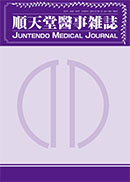Current issue
Displaying 1-9 of 9 articles from this issue
- |<
- <
- 1
- >
- >|
Contents
-
2024 Volume 70 Issue 1 Article ID: JMJ24-70.1-C
Published: 2024
Released on J-STAGE: February 29, 2024
Download PDF (709K)
Reviews: 51th Health Topics for Tokyoites “To survive the 100-year life -What we can do now for healthy longevity-” [1]
-
2024 Volume 70 Issue 1 Pages 2-8
Published: 2024
Released on J-STAGE: February 29, 2024
Advance online publication: December 22, 2023Download PDF (1681K) -
2024 Volume 70 Issue 1 Pages 9-22
Published: 2024
Released on J-STAGE: February 29, 2024
Advance online publication: February 16, 2024Download PDF (1632K)
Perspectives
-
2024 Volume 70 Issue 1 Pages 23-25
Published: 2024
Released on J-STAGE: February 29, 2024
Advance online publication: February 10, 2024Download PDF (894K) -
2024 Volume 70 Issue 1 Pages 26-28
Published: 2024
Released on J-STAGE: February 29, 2024
Advance online publication: February 10, 2024Download PDF (1148K)
Original Articles
-
2024 Volume 70 Issue 1 Pages 29-43
Published: 2024
Released on J-STAGE: February 29, 2024
Advance online publication: December 22, 2023Download PDF (1076K) -
2024 Volume 70 Issue 1 Pages 44-53
Published: 2024
Released on J-STAGE: February 29, 2024
Advance online publication: December 22, 2023Download PDF (629K) -
2024 Volume 70 Issue 1 Pages 54-64
Published: 2024
Released on J-STAGE: February 29, 2024
Advance online publication: December 22, 2023Download PDF (636K)
Publication List
-
2024 Volume 70 Issue 1 Pages 65-85
Published: 2024
Released on J-STAGE: February 29, 2024
Download PDF (659K)
- |<
- <
- 1
- >
- >|
